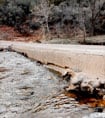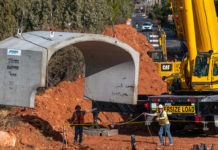Should the city of Sedona condemn private land to buy it, then build a bridge at public expense, so that developers can build on landlocked property?
Larson Newspapers
Should the city of Sedona condemn private land to buy it, then build a bridge at public expense, so that developers can build on landlocked property?
Arizona Revised Statute §12-1202 is forcing the city to ask itself that question about 27 acres owned by Bruce Tobias and Robert and Carol Flynn.
The law states that an owner entitled to the beneficial use of land that’s landlocked may bring an action to condemn and take neighboring lands to the extent necessary to construct access.
When Tobias and the Flynns purchased the parcels in 1993, located behind Radisson Poco Diablo Resort and across a low-water bridge, it was already landlocked by U.S. Forest Service land and the Oak Creek Cliffs subdivision.
“We knew we’d be able to gain access because it’s not legal in Arizona to landlock property,” Tobias said.
The easiest remedy would have been to purchase an easement from the subdivision.Tobias says he and the Flynns met for many months with the subdivision’s homeowners association, but that the meetings were not successful in reaching a mutual agreement as to price or other considerations.
“We offered to help them build a new bridge, a new road; we offered a compromise on density and monetary assistance with their wastewater system,” Tobas said. “The residents of the subdivision remained focused on the fact that they didn’t have to sell us an easement.”
Tobias says that he and the Flynns are still willing to pay the homeowners for an easement, but that the homeowners have refused to speak to them since the late 1990s.
An alternate easement could be gained through the U.S. Forest Service and, in 2002, a federal judge ruled that the Forest Service must give the developers access.
If Tobias and the Flynns choose this route, city staff says it will result in a 3/4-mile roadway through a significant amount of native vegetation and mature native trees along a section of Oak Creek.
In addition, the developers would need to build a 450-foot long and 70-foot high bridge that would spoil the view of existing homeowners, according to area resident Mark Thatcher.
Condemnation of private property by the city, including the existing low-water crossing, would negate the need for a road through the Forest Service and a high bridge over the creek.
However, it would require the city to pay current market value for the various parcels of property required and then to pay for construction of a new bridge.
“The question to the council is are they willing to condemn the current bridge so that a more invasive road is avoided,” City Attorney Mike Goimarac said. “This is only one of several possible options and the city doesn’t have to do it, but it could be a first step toward resolution.”
This option would be costly for the city and Tobias said he is open to the idea of contributing to the expenses, but that he could not agree to any given amount at this time.
“This is the city’s choice to do this, we are not participants,” Tobias said.
A further option would be for the Forest Service to purchase the in-holding from Tobias and Flynn.
“We’ve had numerous discussions with them regarding this opportunity, but it’s not a priority for them,” Tobias said. “They don’t currently have the funding they’d need to do it.”
Judy Adams, a ranger in the Red Rock Ranger District, said that the U.S. Forest Service had considered purchasing the in-holding but that it wasn’t adequately compelling to warrant purchase funds.
“It’s very difficult to get funding when a property doesn’t have the types of species or archaeology that need protection,” Adams said. “In addition, this property is near existing development and wouldn’t have the impact of an in-holding that’s in a remote area.”
The president of the Oak Creek Cliffs subdivision could not be reached for comment by press time.
The Sedona City Council met to discuss this issue Tuesday, Jan. 8, however, the results of the discussion were not available by press time.
Susan Johnson can be reached at 282-7795, Ext. 129 or e-mail sjohnson@larsonnewspapers.com




















